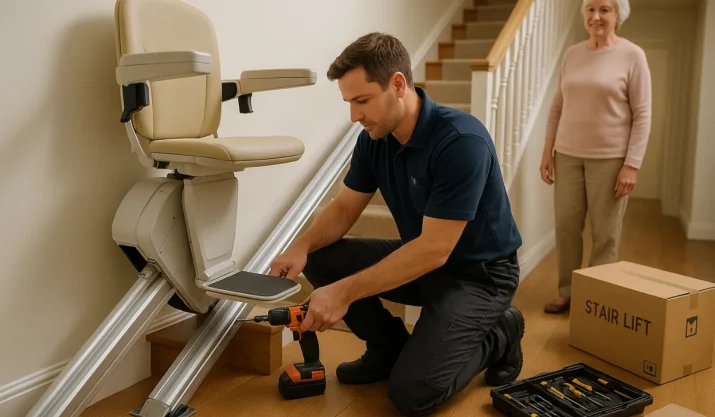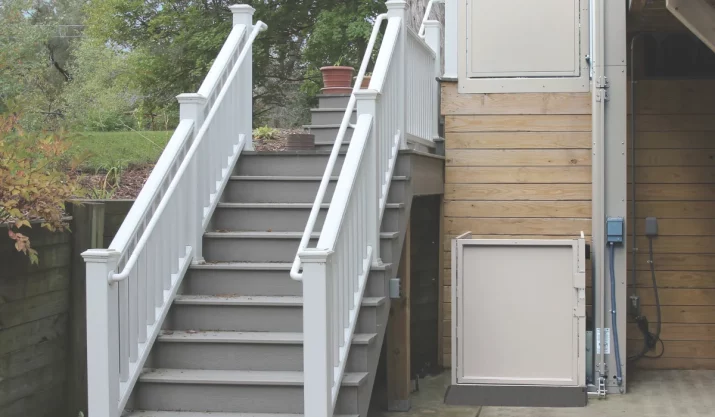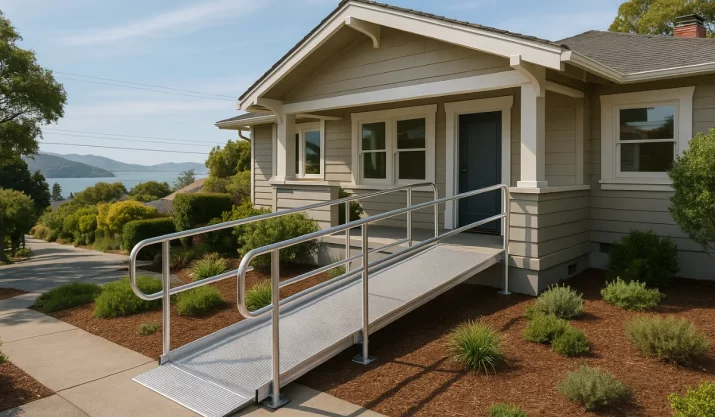Can a Stair Lift Be Installed Without Damaging My Walls or Floors?

Table of Contents
Potential damage is one of the first things you think about before installing a stairlift. You’ll think, will the walls need to be torn into to install the lift? Will the installation ruin my carpet or hardwood floors?
The good news is that modern stair lift installation will rarely cause any permanent damage to your walls or floors. In most cases, any changes made during installation are small, discreet, and fully reversible.
In this article, we’ll break down exactly how stair lifts are installed, what kind of impact they may have on your home, and how to avoid long-term issues.
Key takeaways
- Stair lifts attach directly to the stair treads, not the walls. This means your drywall and banister stay untouched.
- Stair lifts cause little to no damage to your floors. You can usually patch or cover the small holes from the screws when you remove the stair lift.
- Both straight and curved stair lifts use brackets that fit your staircase, without changing the structure.
- If you rent or want to upgrade your stairlift, professional installers can easily remove the lift without leaving a mess.
How stair lift installation works
Stair lifts provide individuals with mobility challenges a means to stay safe and independent. According to a study, older adults are disproportionately susceptible to hospitalizations and fatalities due to stair-related falls. Installing a stair lift helps prevent falls and keeps you or your loved ones safe.
Many people often think stair lifts need to be mounted on the wall or need significant changes to their home. But that’s not true. A stair lift, also called a chair lift, is attached to the stairs, not the wall. That’s a significant difference.
The main parts of a stair lift are:
- A rail that goes along the stairs
- Support brackets that hold the rail in place
- A chair with a seat, footrest, and armrests that moves along the rail
Installing a stair lift is one of the easiest home changes you can make to improve mobility. The brackets are screwed into the stair treads. These holes are small, just a few inches deep, and don’t weaken your stairs.
Will a stair lift damage my walls?
No, walls are not touched during a standard stair lift installation.
The rail is attached directly to the stairs. The installation won’t touch your handrail, banister, or wall. This means your drywall or plaster stays untouched even if you install a chair lift. Even stair lifts for curved stairs are designed to avoid walls.
The only time a wall might be used is if you need a nearby electrical outlet for power. You also won’t need to worry about the stair lift during power outages. Many chair lifts come with battery backup, allowing them to continue operating even in the event of a power outage. This safety feature ensures continued mobility during power outages.
Will the flooring be damaged?
Stair lift installations rarely damage floors, and in the unfortunate event that something goes wrong, the damage will be minimal. Here’s how it breaks down:
- Carpeted stairs: The screws go through the carpet into the stair tread. If the lift is removed later, the small holes will be difficult to notice, as the carpet fibers will generally hide them.
- Hardwood stairs: Screws will leave minor entry points on the hardwood. However, these small holes can be patched with wood filler and then stained to match the surrounding area.
- Tile stairs: Since tile is more delicate than hardwood, more care is needed. However, skilled installers can anchor brackets between tiles or use specialized techniques to prevent cracking.
Stair lifts offer a more straightforward, faster installation compared to home lifts and wheelchair lifts.
If you’re concerned about resale value or preservation, discuss removable or reversible options with your installer. If you live in a rental, some stair lift rental programs use minimally invasive brackets explicitly designed for temporary use.
Are all stair lifts installed the same way?
The principles of installation for stair lifts are the same. However, not all chair lift models are the same. They will differ in how they’re customized for your staircase:
- Straight stairlifts are the most straightforward and least invasive to install.
- Curved stairlifts are built to match your staircase’s exact shape, which can take more time to install, but still avoids wall damage.
- Outdoor stairlift models are installed similarly to indoor lifts. However, outdoor stairlifts are weather-sealed and built with special attention to water drainage and slip resistance.
Whether you’re installing at the bottom of the stairs or over multiple landings, reputable brands like Bruno offer high-quality lifts designed to fit your space and lifestyle.
What if I want to remove the stairlift later?
If you only need the stairlift short-term, don’t worry. Stairlift removal is a quick and straightforward process. Professional stairlift technicians, like our team at California Mobility, can cleanly and quickly detach the brackets and rails.
You also won’t need to worry about unsightly small holes left behind by the stair lift, as the mounting holes in the stair treads can be filled or patched.
Maintaining historical finishes is a top priority for homeowners with older homes in California. Fortunately, accessibility standards are more flexible for older homes. If you are concerned about any potential damage during the removal process, you can discuss this with us or your trusted technician during your free consultation.
Tips to avoid stairlift damage
Installing a stairlift in your home is a significant home modification. More often than not, stair lifts are not permanent fixtures in your home. Whether you need the home lift for support after surgery, while recovering from an injury, or are caring for someone with limited mobility, the time for removing them eventually comes around.
- Use a certified stairlift company: Look for companies that specialize in home accessibility and have experience with your type of staircase.
- Ask about reversible installation options, especially if you’re renting or only need the lift temporarily.
- Confirm bracket placement before installation: You can request that brackets be placed in areas less visible or where repairs would be more straightforward later.
- Plan for power access early: Avoid unnecessary wall work by selecting an appropriate electrical outlet location in advance.
If you’d like a free quote from a trusted California stairlift company, our team can walk you through your best options.
Final thoughts
Stair lifts are designed with homeowners in mind. Whether you’re installing one temporarily or for long-term accessibility, the process is surprisingly gentle on your walls and floors.
At California Mobility, we specialize in professional stairlift installation, and our services span across the state. Suppose you are a California homeowner seeking a safe, efficient, and damage-free chair lift installation. In that case, we offer complimentary in-home assessments to help you find the ideal stairlift solution for your specific needs.
Contact us today to receive a free quote or to schedule an in-home evaluation.








